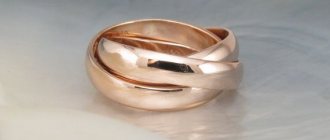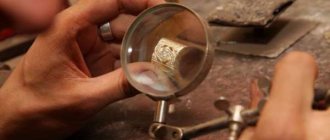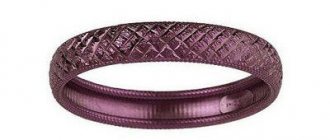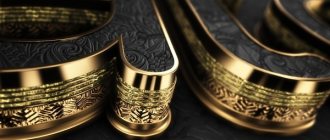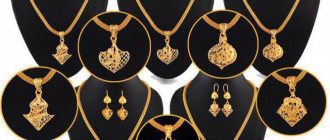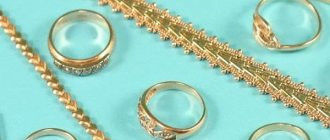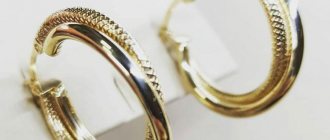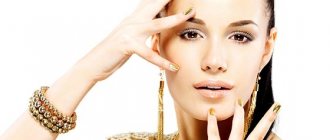When we mention gold, we imagine a precious metal that is used to make elegant jewelry, decorative items, and cutlery. It is believed that gold is something aristocratic, sparkling and expensive.
Confectionery art also did not stand aside; here the aesthetic side plays an important role - it also uses gold as a decoration for the culinary masterpieces of masters.
What is edible gold
Edible gold leaf is a very thin sheet that looks like foil.
It has neither taste nor smell, consists of 90% yellow metal, and natural silver is added to its composition to stabilize it. The supplement is absolutely safe to eat
and is used for the design of confectionery and other products as a decorative element. It is hypoallergenic and does not have any effect on the aroma and taste of the dish itself. According to European certificates, edible gold has its own unique number – E174.
Its manufacturing process is quite labor-intensive, and if you also take into account the cost of raw materials, then the rather high price of edible gold is quite understandable
.
As a result of production, absolutely smooth thin sheets are obtained, without cracks or creases. They are cut to size, lined with parchment paper and placed in packages. Residues and waste also find their use, and simpler jewelry options are made from them. They are available in the form:
- flakes, both large and small sizes
. The former can be used to create voluminous decorations for culinary products, the latter - as sprinkles; - powder
; - miniature objects
, for example, gold bullets, nuggets, ingots; - themed decorations
with inscriptions, hearts, Christmas trees, bells, etc.
With their help, confectionery products take on, one might say, a unique, expensive, elegant look.
This is especially true for exquisite celebrations - dishes decorated with gold will emphasize the special status of the event. The cost of such decoration can hardly be defined as budgetary, but the effect and impression made are worth it. Guests will definitely remember such original treats
. No analogues reminiscent of gold color can compare with the brilliance and beauty of real metal.
No special storage conditions are provided - the product does not deteriorate, does not break in the packaging, does not become moldy or get wet. You can store it for a year, but you need to treat it carefully and with care.
Golden pizza will help improve your health
A Swedish chef named Ismail Ertekin is convinced that eating a small amount of such a noble metal as gold has a beneficial effect on health. In particular, it improves immunity. But simply eating gold in its pure form is not very pleasant. Another thing is to combine its intake with eating your favorite food, for example, pizza, which almost everyone loves. This is the kind of precious pizza that is served at the Avanti restaurant, where Ismail works. This establishment is located in Zurich, and, thanks to the inclusion of golden pizza in the menu, has already become quite popular.
It was once believed that wearing jewelry was good for your health. For example, original gold earrings can supposedly cure diathesis. And here is a new trend - golden food, which is decorated with a special precious, but at the same time edible, coating. Moreover, in the case of pizza, any type of this dish can be decorated with gold. All you have to do is express your wishes to the waiter, and the pizza you like will turn golden.
Among other things, according to the chef who creates golden food, it has a positive effect on mood. Thanks to its round shape and gold plating, the pizza looks like the sun, and will be especially appropriate on a sad, cloudy day. By the way, one serving of sun food has a fairly affordable price - it costs nineteen and a half Swiss francs (or 19.8 US dollars). I must say that this is much cheaper than boosting immunity with earrings or a ring. But it is important not to overdo it with gold intake - to boost immunity, the amount of the noble metal should be small.
History of appearance
Edible gold leaf has been widely used as an additive in dishes and decorations since around 2009.
However, the tradition of using metal in food dates back to the Middle Ages, when alchemists in Arab countries and China conducted their experiments. Later, Europe adopted their experience, the first drinks with precious metal appeared - this was a real luxury and a sign of special status; not everyone could afford to “eat and drink” gold
.
Today, the gold additive in dishes is used quite widely, oddly enough, but India has been the leader in this regard for a long time. Perhaps this fact also depends on local traditions - Indians often eat gold a lot, this is due to the belief in its unique qualities and its ability to benefit the entire body.
What does the metal contain?
The metal is obtained naturally, since in natural conditions it has a native state. It is included in the periodic table as an element of the periodic table.
In recent years, scientists have learned to extract valuable material using chemical methods. This is all thanks to the development of modern technologies.
As soon as it was possible to obtain it in this way, laboratory research immediately began. Their results showed that the chemically derived material is no different from the natural one.
The unique chemical composition has led the metal to the list of inert substances that are not able to degrade under the influence of the environment.
The element can dissolve only in a mixture of nitrogen and concentrated hydrochloric acid. This mixture is called “royal vodka”.
How it can be used
Until recently, culinary jewelry made of gold was available exclusively in elite and very expensive establishments.
They were used to decorate cakes, pastries, and various desserts. But the use of the precious metal is not limited to this. For example, in France, gold dye is added to champagne - this makes the taste and appearance of the drink even more noble.
. Some candy manufacturers make edible packaging from edible gold leaf. In expensive establishments in Japan, it is added to sake, and sheets of it are placed in sushi.
Thus, confectionery is not the only area of application for gold jewelry
. In cooking, it is used as an original seasoning, giving a unique bright accent to the dish. It is also added as decor for exclusive food serving.
Gold was also used in coffee shops. With its help, you can make a real work of art from one small cup of hot drink.
The additive would be used much more widely, but so far the cost is an obstacle; it is so high that its use for mass production of confectionery products is unprofitable. And this is perhaps the only limitation.
HOW DO CHEFS COOK EDIBLE GOLD?
Working with edible gold can be a painstaking process. Not only because it is very expensive so any waste must be kept to a minimum, but also because of its extremely delicate nature. So, perfecting a technique requires a certain amount of skill—plus a lot of practice.
Because edible gold breaks easily and sticks to your hands, professional chefs use special tools to assist in the decorating process.
Edible Gold Chef Tool Set:
- A set of food brushes of different sizes (often using a special gilding brush)
- Tweezers
- Sharp paring knife
- Shaker/rag
Application depends on the type of edible metal used. Fine dust and flakes can be carefully removed using a shaker. Slightly larger pieces, such as shapes or petals, are best placed with tweezers. Complete worksheets require a lot of precision, practice, and patience. The surface to be decorated must be slightly wetted, and then carefully apply edible gold, finally smoothing it with a thin brush.
Understanding how to expertly prepare food using edible precious metals takes dishes from average to truly extravagant. Using them in food is a great way to not only delight customers, but also surprise them, creating truly memorable and often remembered dining experiences.
About benefits and harms
It is believed that gold should be consumed to cleanse the body, for problems with the gastrointestinal tract and heart.
Of course, such treatment is practically inaccessible to the average person, but from this we can conclude that the metal does not cause any harm to the body. Gold is not absorbed into the blood, does not dissolve, is not retained and does not accumulate in the body.
. Takes part in strengthening the immune system and can even have an effect on enhancing brain activity.
Even in ancient times, gold was prescribed for the prevention and treatment of heart attacks, and currently numerous studies are being conducted in this direction, based on the results of which it can be said that indeed, in certain doses, the metal has a positive effect on the functioning of the cardiovascular, nervous and respiratory systems. Gold ions help the body slow down the aging process and remove toxins. Of course, such an effect is not guaranteed after eating one cake decorated with a golden curl, but nevertheless, the benefits of gold are obvious.
Use in the food industry
This dye is used very rarely in the production of various foods, as it is considered one of the most expensive. More often they decorate exquisite desserts in elite confectionery factories.
Typically, gold sprinkles decorate chocolates, candies, pastries, cakes, pralines and ice cream. Various dragees are also colored using E175.
You can often find gold sprinkles in elite alcoholic drinks, namely vodka and liqueur. This decoration adds sophistication to alcoholic drinks.
Ways to decorate cakes and desserts
Applying edible foil to decorate desserts is scary, but not difficult. The easiest way is to use flakes. It is enough to scatter them on top of the cake or pastry in a chaotic order.
If you have small gold sparkles that you want to decorate chocolates or cakepops with, you can secure them with the icing that has not yet cooled, carefully sprinkling the dessert. As a result, you will end up with something like this:
A few more options for decorating chocolates:
The main thing is not to take the cereal with your hands. You can easily wrinkle them and leave greasy fingerprints on the surface. It's better to arm yourself with tweezers and save every piece.
How to attach gold leaf
Working with foil is a little more difficult than with flakes. If you are planning to cover a whole cake, you may not get it perfect the first time. Still, this is quite a painstaking job, for which you will need:
- fondant-covered cake;
- a bowl of water;
- book with foil;
- scissors;
- paper towel;
- gloves.
Operating procedure:
- Separate the paper sheet with foil from the book. Trim off excess paper on 3 sides. We will hold on to the last piece as we work.
- Fold the paper towel to form a tight, easy-to-work rectangle. Lightly moisten with water and blot the mastic. You need to process a small area at a time, a little larger than gold leaf. Do not wet the mastic too much, otherwise it will melt. We just blot it.
- Glue the gold leaf to the cake. To do this, apply the foil to the mastic and gently smooth it through the paper in one direction.
- We wet the adjacent area without touching the gold coating. Otherwise it will tear easily. Repeat the procedure until the cake is finished.
- If there are gaps left, cut the foil along with the paper to size and apply it carefully, trying not to catch the existing layer.
Gold leaf should not be touched with your hands, cloth or brush. It breaks and deforms very easily. And considering the cost of decor, every mistake will be expensive. But as a result you will get this beauty:
You also don't have to cover the entire cake. It is enough to make a beautiful pattern with the rim, without even worrying about making it even. This way, both you and the client will save money without losing the attractiveness of the decor:
Here is another simple idea for decorating a money cake. You can take chocolate coins and cover them with kandurin:
I love gold accents like these on desserts. And you? Or is it all just show-off and gypsyism? Share your opinion in the comments.
Edible precious metals - a brief history
The use of edible precious metals dates back to the times of the Egyptian pharaohs. They believed that gold was one of the ways to gain the favor of the gods, so they used it in the form of an elixir to try to achieve this. They also believed that gold had powerful restorative properties that healed the body and promoted youth.
Europeans used it as early as the 15th century for medicinal purposes. In the 16th century it was used as a food garnish at elaborate banquets as a sign of wealth.
Eastern civilizations also used edible precious metals in their foods, both as a garnish and for its supposed medicinal properties.
Today, chefs around the world use precious metals in a variety of cuisines, from gourmet dishes to fast foods such as hamburgers or hot dogs. It is used to dazzle and delight the customer by playing on one of the most important senses when it comes to enjoying food - sight.
Both the European Union and the United States allow the use of gold to decorate food. In the luxury food industry it is used in the form of powder, leaves, flakes or sprinkles.
Edible gold is a delight for luxury cuisine lovers everywhere.
The largest consumer is India, producing about 12 tons of culinary gold per year. Gold leaf is used to decorate traditional baked goods as well as some lamb delicacies served at weddings and religious festivals. In China, some types of venison are sprinkled with gold, and in Japan, it is customary to exchange good wishes for the new year over a cup of sake containing gold. Some of Japan's top chefs decorate their best sashimi with pure gold. In Pakistan, gold is sometimes consumed for its supposed aphrodisiac and stimulant properties.
In France and Switzerland, famous master chocolatiers decorate their truffles with fragments of gold leaf, creating a magical experience for the taste buds.
